Financial Analysis: Budget Variances, Performance, Recommendations
VerifiedAdded on 2023/06/12
|14
|2245
|410
Report
AI Summary
This report provides a comprehensive analysis of Houzit's financial performance, focusing on budget analysis and variance reporting. It examines sales budgets, profit budgets, and debtor analysis, identifying issues such as high anticipated costs, unclear discount records, and inadequate debtor balance reconciliation. The report includes a variance report comparing budgeted and actual performance, revealing unfavorable sales results and gross margins. It also assesses Houzit's performance within the retail industry, highlighting the impact of credit policies on debtor balances and liquidity. Recommendations are provided to improve cost management and financial management practices, including the implementation of an ERP system and enhanced internal controls. The report also addresses tax compliance and relevant regulations under the Corporation Act 2001.
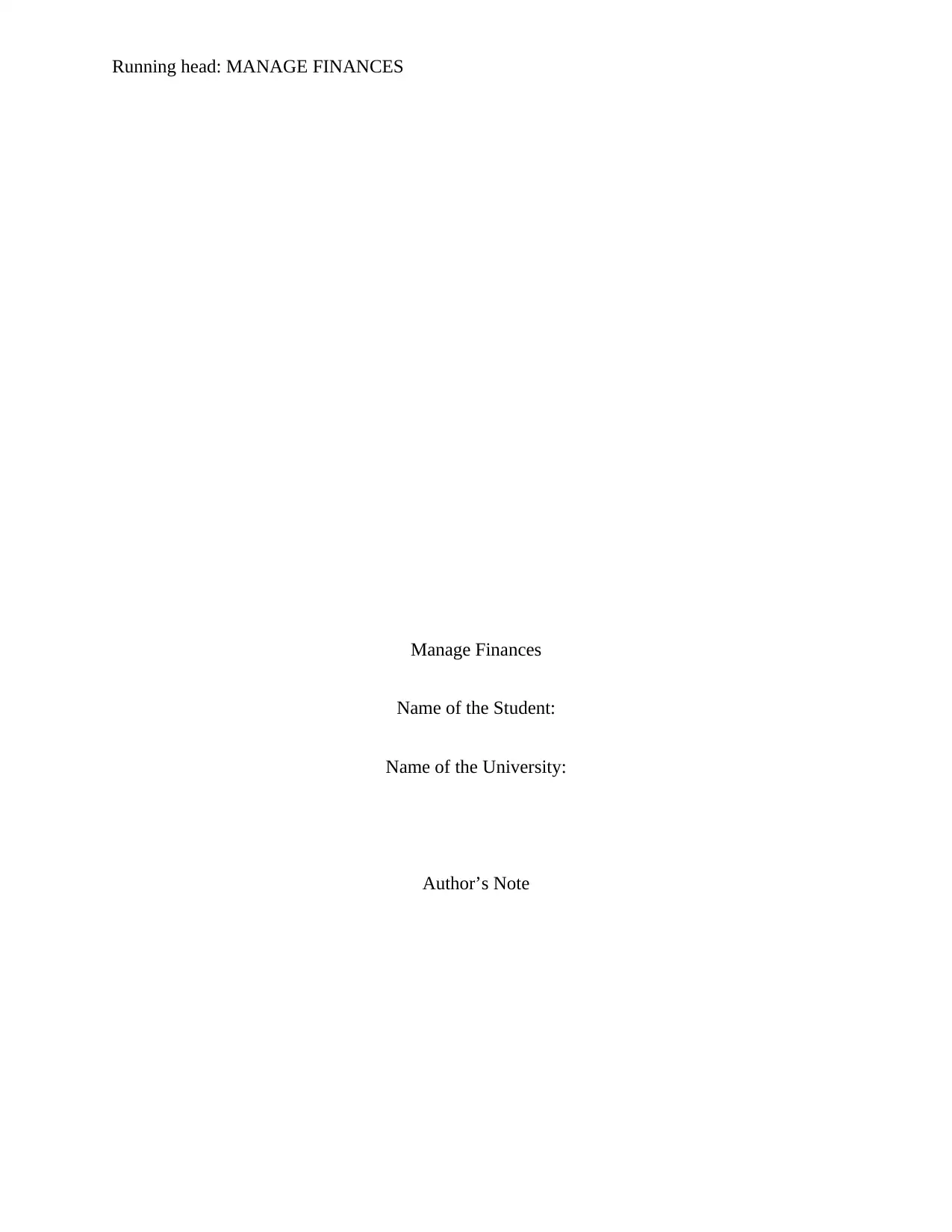
Running head: MANAGE FINANCES
Manage Finances
Name of the Student:
Name of the University:
Author’s Note
Manage Finances
Name of the Student:
Name of the University:
Author’s Note
Paraphrase This Document
Need a fresh take? Get an instant paraphrase of this document with our AI Paraphraser
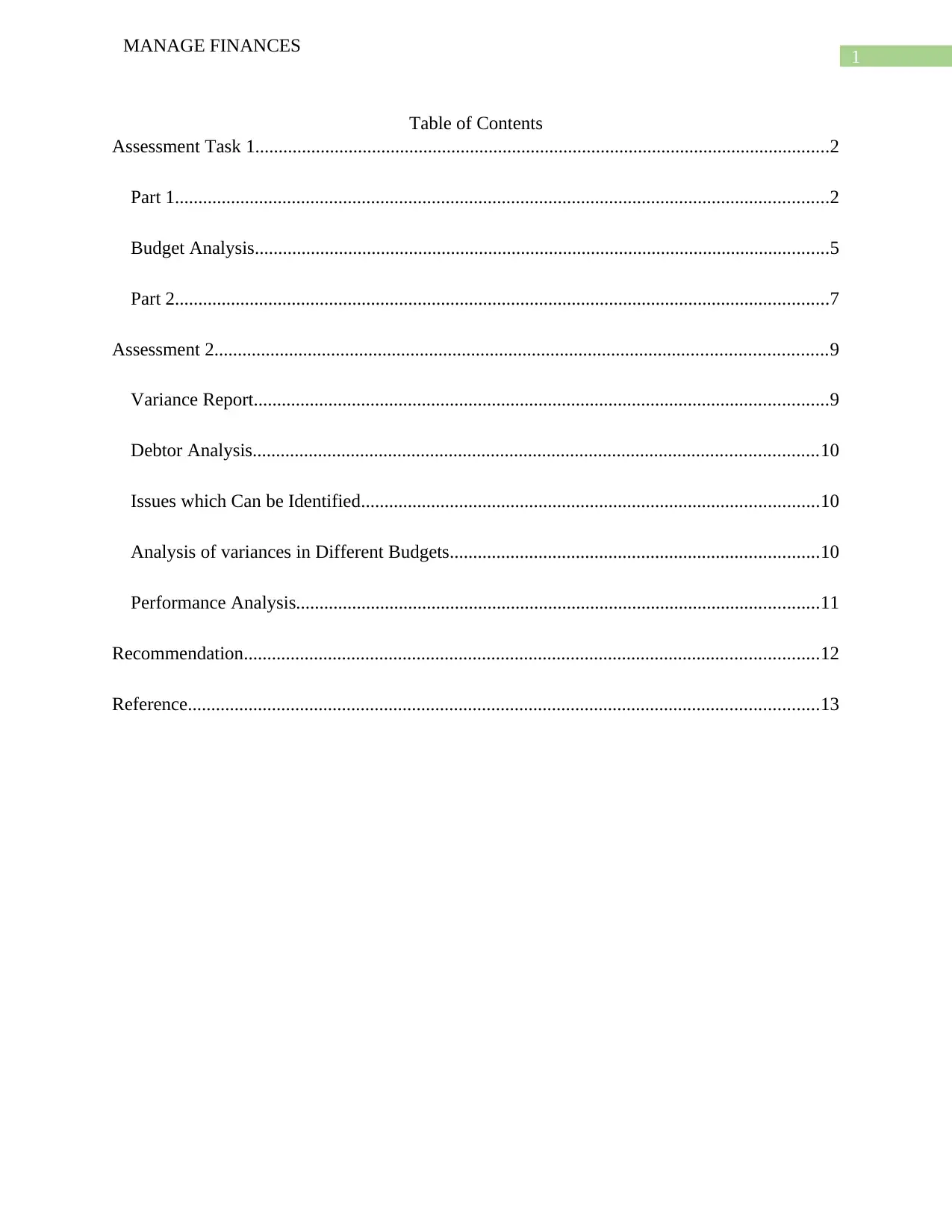
1
MANAGE FINANCES
Table of Contents
Assessment Task 1...........................................................................................................................2
Part 1............................................................................................................................................2
Budget Analysis...........................................................................................................................5
Part 2............................................................................................................................................7
Assessment 2...................................................................................................................................9
Variance Report...........................................................................................................................9
Debtor Analysis.........................................................................................................................10
Issues which Can be Identified..................................................................................................10
Analysis of variances in Different Budgets...............................................................................10
Performance Analysis................................................................................................................11
Recommendation...........................................................................................................................12
Reference.......................................................................................................................................13
MANAGE FINANCES
Table of Contents
Assessment Task 1...........................................................................................................................2
Part 1............................................................................................................................................2
Budget Analysis...........................................................................................................................5
Part 2............................................................................................................................................7
Assessment 2...................................................................................................................................9
Variance Report...........................................................................................................................9
Debtor Analysis.........................................................................................................................10
Issues which Can be Identified..................................................................................................10
Analysis of variances in Different Budgets...............................................................................10
Performance Analysis................................................................................................................11
Recommendation...........................................................................................................................12
Reference.......................................................................................................................................13
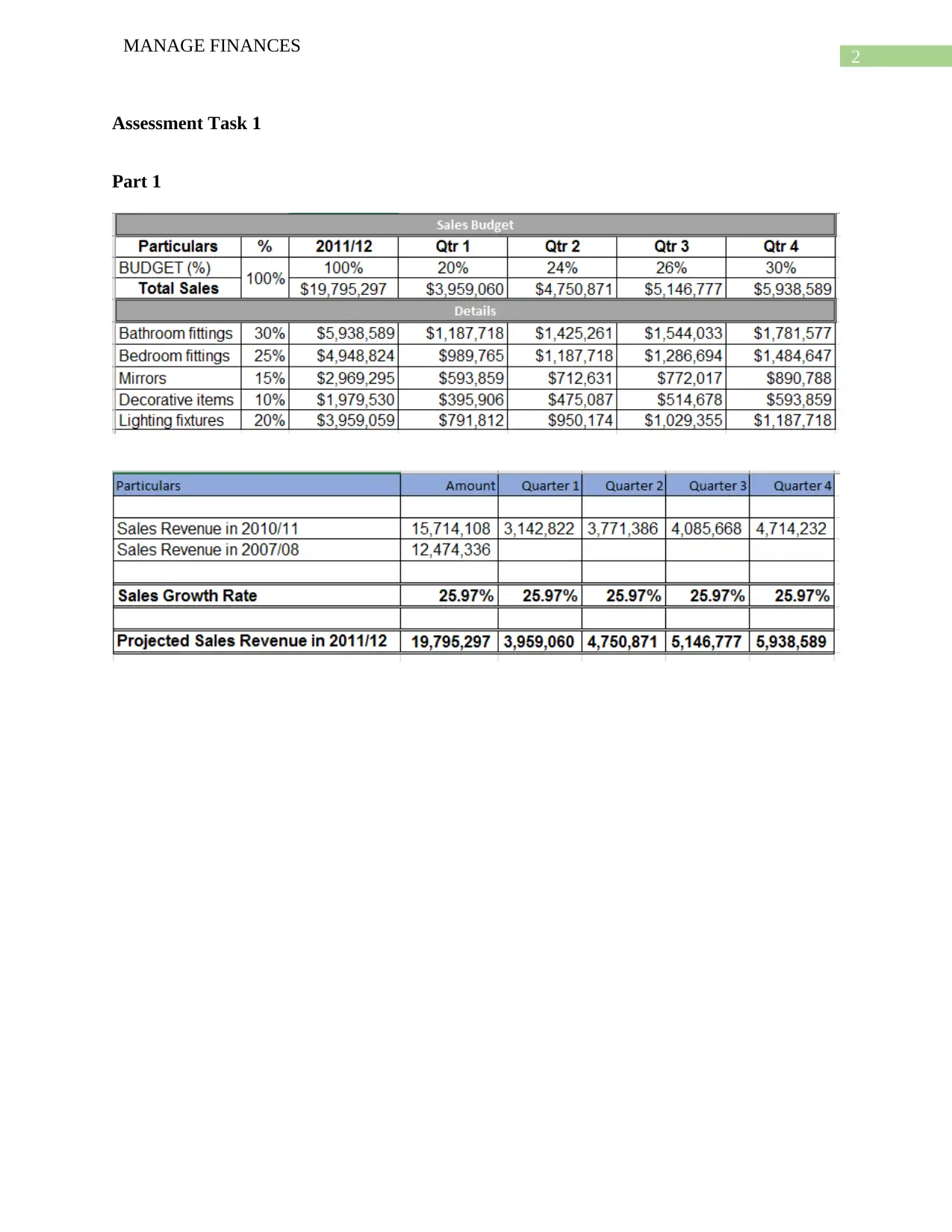
2
MANAGE FINANCES
Assessment Task 1
Part 1
MANAGE FINANCES
Assessment Task 1
Part 1
⊘ This is a preview!⊘
Do you want full access?
Subscribe today to unlock all pages.

Trusted by 1+ million students worldwide
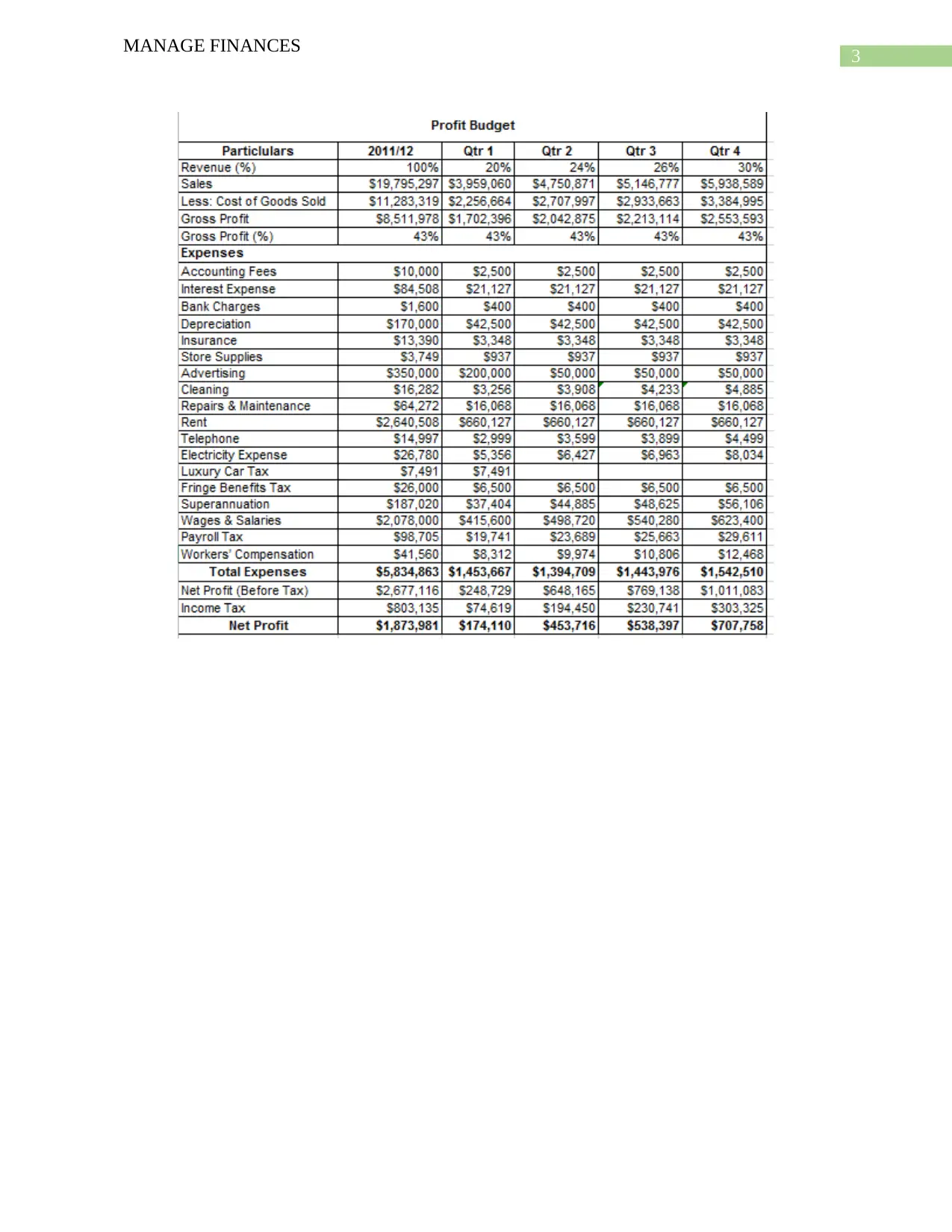
3
MANAGE FINANCES
MANAGE FINANCES
Paraphrase This Document
Need a fresh take? Get an instant paraphrase of this document with our AI Paraphraser
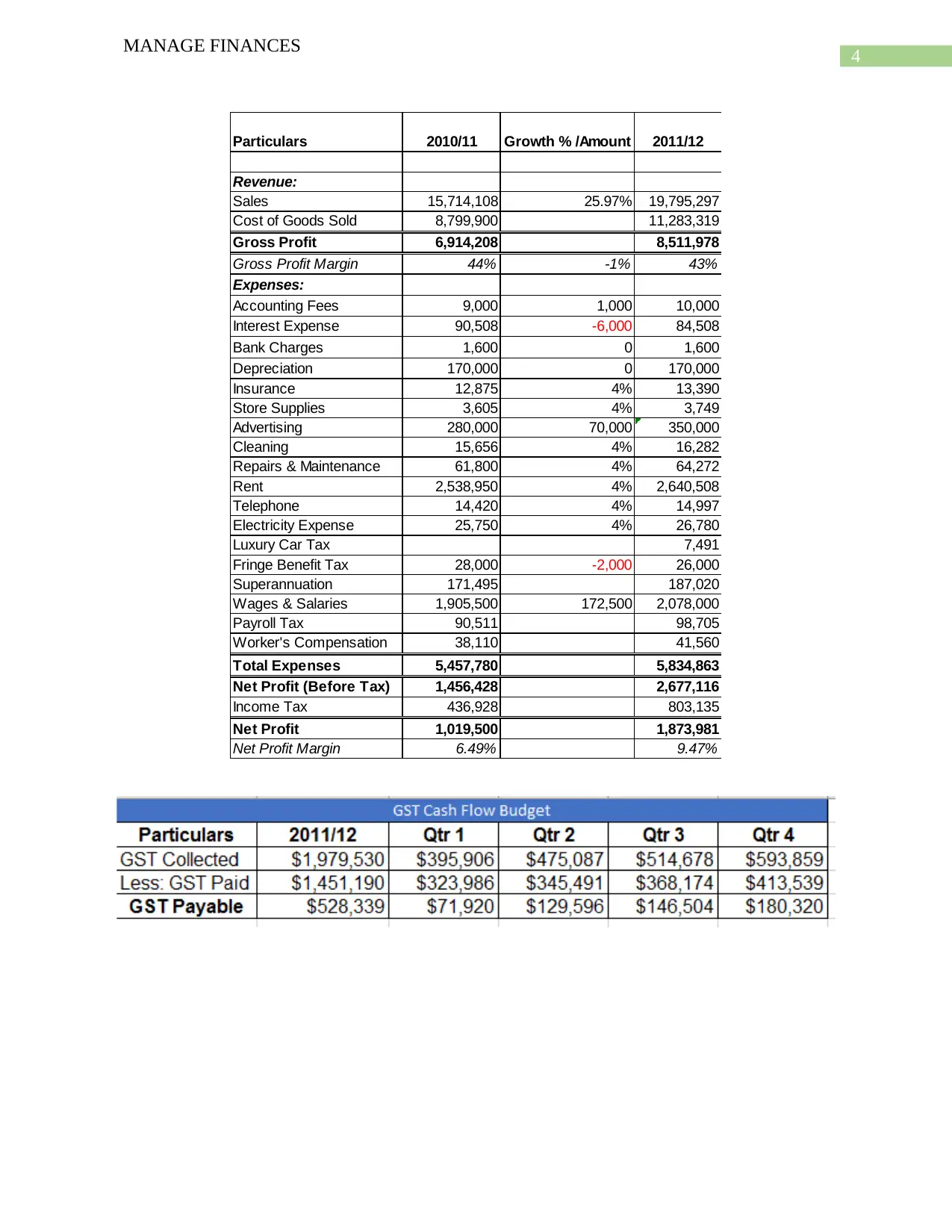
4
MANAGE FINANCES
Particulars 2010/11 Growth % /Amount 2011/12
Revenue:
Sales 15,714,108 25.97% 19,795,297
Cost of Goods Sold 8,799,900 11,283,319
Gross Profit 6,914,208 8,511,978
Gross Profit Margin 44% -1% 43%
Expenses:
Accounting Fees 9,000 1,000 10,000
Interest Expense 90,508 -6,000 84,508
Bank Charges 1,600 0 1,600
Depreciation 170,000 0 170,000
Insurance 12,875 4% 13,390
Store Supplies 3,605 4% 3,749
Advertising 280,000 70,000 350,000
Cleaning 15,656 4% 16,282
Repairs & Maintenance 61,800 4% 64,272
Rent 2,538,950 4% 2,640,508
Telephone 14,420 4% 14,997
Electricity Expense 25,750 4% 26,780
Luxury Car Tax 7,491
Fringe Benefit Tax 28,000 -2,000 26,000
Superannuation 171,495 187,020
Wages & Salaries 1,905,500 172,500 2,078,000
Payroll Tax 90,511 98,705
Worker's Compensation 38,110 41,560
Total Expenses 5,457,780 5,834,863
Net Profit (Before Tax) 1,456,428 2,677,116
Income Tax 436,928 803,135
Net Profit 1,019,500 1,873,981
Net Profit Margin 6.49% 9.47%
MANAGE FINANCES
Particulars 2010/11 Growth % /Amount 2011/12
Revenue:
Sales 15,714,108 25.97% 19,795,297
Cost of Goods Sold 8,799,900 11,283,319
Gross Profit 6,914,208 8,511,978
Gross Profit Margin 44% -1% 43%
Expenses:
Accounting Fees 9,000 1,000 10,000
Interest Expense 90,508 -6,000 84,508
Bank Charges 1,600 0 1,600
Depreciation 170,000 0 170,000
Insurance 12,875 4% 13,390
Store Supplies 3,605 4% 3,749
Advertising 280,000 70,000 350,000
Cleaning 15,656 4% 16,282
Repairs & Maintenance 61,800 4% 64,272
Rent 2,538,950 4% 2,640,508
Telephone 14,420 4% 14,997
Electricity Expense 25,750 4% 26,780
Luxury Car Tax 7,491
Fringe Benefit Tax 28,000 -2,000 26,000
Superannuation 171,495 187,020
Wages & Salaries 1,905,500 172,500 2,078,000
Payroll Tax 90,511 98,705
Worker's Compensation 38,110 41,560
Total Expenses 5,457,780 5,834,863
Net Profit (Before Tax) 1,456,428 2,677,116
Income Tax 436,928 803,135
Net Profit 1,019,500 1,873,981
Net Profit Margin 6.49% 9.47%
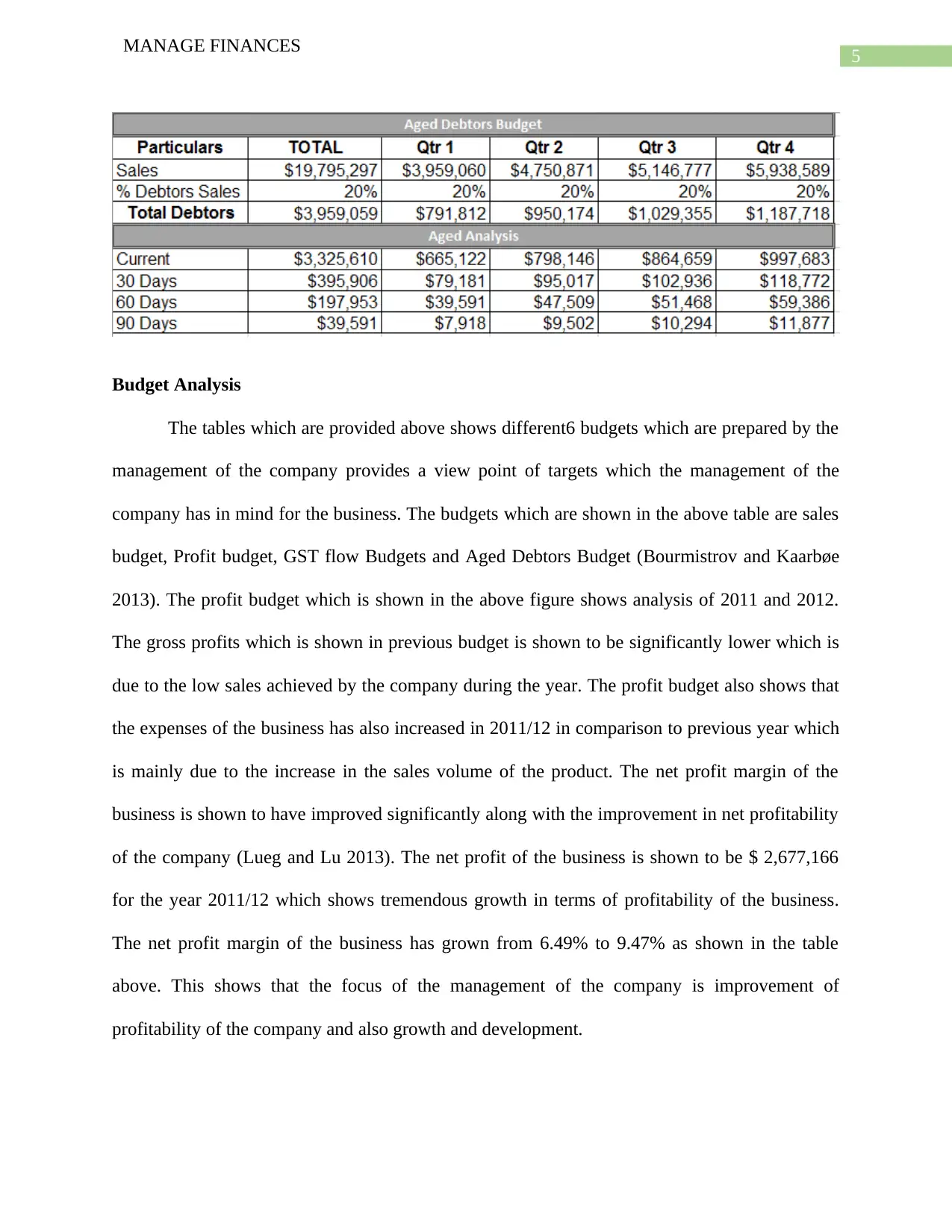
5
MANAGE FINANCES
Budget Analysis
The tables which are provided above shows different6 budgets which are prepared by the
management of the company provides a view point of targets which the management of the
company has in mind for the business. The budgets which are shown in the above table are sales
budget, Profit budget, GST flow Budgets and Aged Debtors Budget (Bourmistrov and Kaarbøe
2013). The profit budget which is shown in the above figure shows analysis of 2011 and 2012.
The gross profits which is shown in previous budget is shown to be significantly lower which is
due to the low sales achieved by the company during the year. The profit budget also shows that
the expenses of the business has also increased in 2011/12 in comparison to previous year which
is mainly due to the increase in the sales volume of the product. The net profit margin of the
business is shown to have improved significantly along with the improvement in net profitability
of the company (Lueg and Lu 2013). The net profit of the business is shown to be $ 2,677,166
for the year 2011/12 which shows tremendous growth in terms of profitability of the business.
The net profit margin of the business has grown from 6.49% to 9.47% as shown in the table
above. This shows that the focus of the management of the company is improvement of
profitability of the company and also growth and development.
MANAGE FINANCES
Budget Analysis
The tables which are provided above shows different6 budgets which are prepared by the
management of the company provides a view point of targets which the management of the
company has in mind for the business. The budgets which are shown in the above table are sales
budget, Profit budget, GST flow Budgets and Aged Debtors Budget (Bourmistrov and Kaarbøe
2013). The profit budget which is shown in the above figure shows analysis of 2011 and 2012.
The gross profits which is shown in previous budget is shown to be significantly lower which is
due to the low sales achieved by the company during the year. The profit budget also shows that
the expenses of the business has also increased in 2011/12 in comparison to previous year which
is mainly due to the increase in the sales volume of the product. The net profit margin of the
business is shown to have improved significantly along with the improvement in net profitability
of the company (Lueg and Lu 2013). The net profit of the business is shown to be $ 2,677,166
for the year 2011/12 which shows tremendous growth in terms of profitability of the business.
The net profit margin of the business has grown from 6.49% to 9.47% as shown in the table
above. This shows that the focus of the management of the company is improvement of
profitability of the company and also growth and development.
⊘ This is a preview!⊘
Do you want full access?
Subscribe today to unlock all pages.

Trusted by 1+ million students worldwide
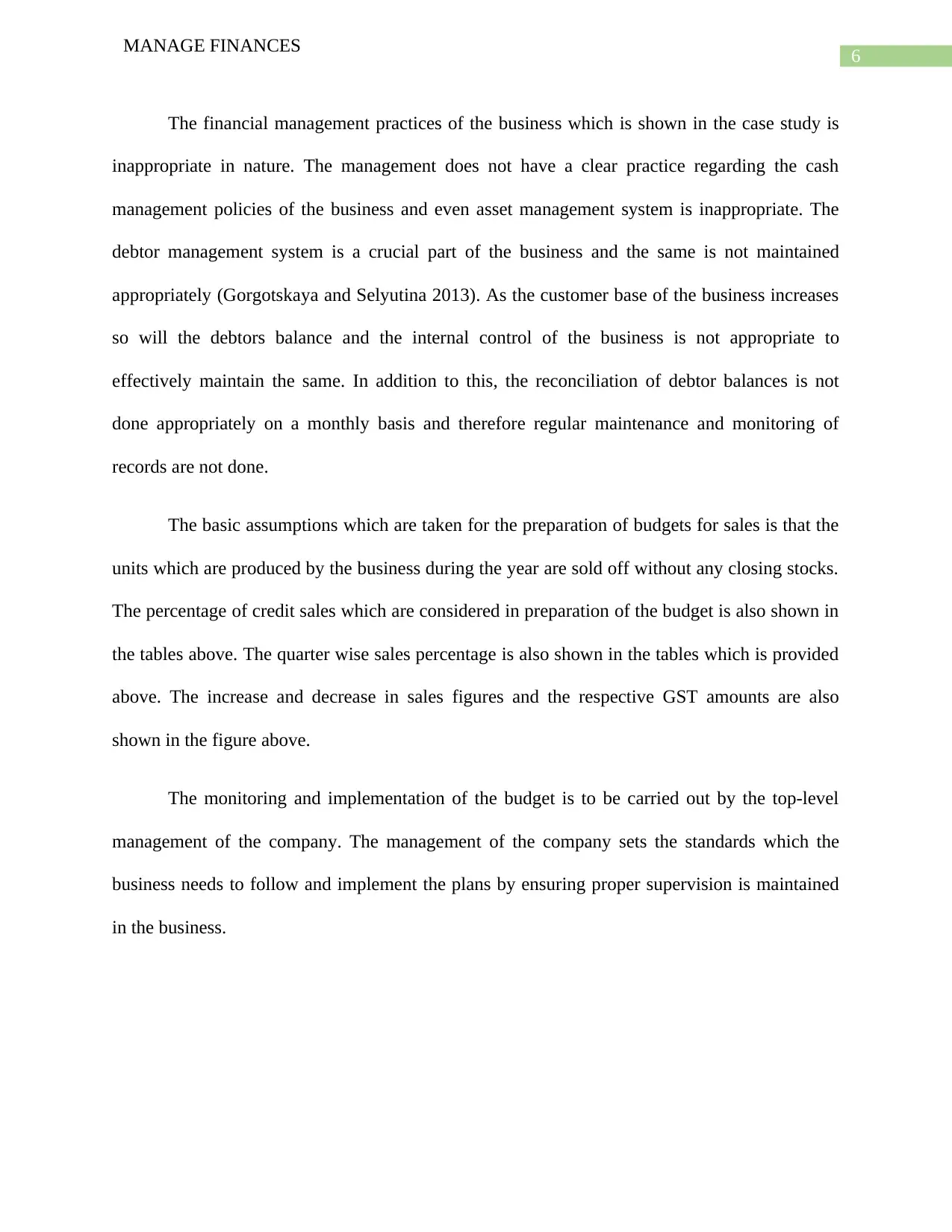
6
MANAGE FINANCES
The financial management practices of the business which is shown in the case study is
inappropriate in nature. The management does not have a clear practice regarding the cash
management policies of the business and even asset management system is inappropriate. The
debtor management system is a crucial part of the business and the same is not maintained
appropriately (Gorgotskaya and Selyutina 2013). As the customer base of the business increases
so will the debtors balance and the internal control of the business is not appropriate to
effectively maintain the same. In addition to this, the reconciliation of debtor balances is not
done appropriately on a monthly basis and therefore regular maintenance and monitoring of
records are not done.
The basic assumptions which are taken for the preparation of budgets for sales is that the
units which are produced by the business during the year are sold off without any closing stocks.
The percentage of credit sales which are considered in preparation of the budget is also shown in
the tables above. The quarter wise sales percentage is also shown in the tables which is provided
above. The increase and decrease in sales figures and the respective GST amounts are also
shown in the figure above.
The monitoring and implementation of the budget is to be carried out by the top-level
management of the company. The management of the company sets the standards which the
business needs to follow and implement the plans by ensuring proper supervision is maintained
in the business.
MANAGE FINANCES
The financial management practices of the business which is shown in the case study is
inappropriate in nature. The management does not have a clear practice regarding the cash
management policies of the business and even asset management system is inappropriate. The
debtor management system is a crucial part of the business and the same is not maintained
appropriately (Gorgotskaya and Selyutina 2013). As the customer base of the business increases
so will the debtors balance and the internal control of the business is not appropriate to
effectively maintain the same. In addition to this, the reconciliation of debtor balances is not
done appropriately on a monthly basis and therefore regular maintenance and monitoring of
records are not done.
The basic assumptions which are taken for the preparation of budgets for sales is that the
units which are produced by the business during the year are sold off without any closing stocks.
The percentage of credit sales which are considered in preparation of the budget is also shown in
the tables above. The quarter wise sales percentage is also shown in the tables which is provided
above. The increase and decrease in sales figures and the respective GST amounts are also
shown in the figure above.
The monitoring and implementation of the budget is to be carried out by the top-level
management of the company. The management of the company sets the standards which the
business needs to follow and implement the plans by ensuring proper supervision is maintained
in the business.
Paraphrase This Document
Need a fresh take? Get an instant paraphrase of this document with our AI Paraphraser
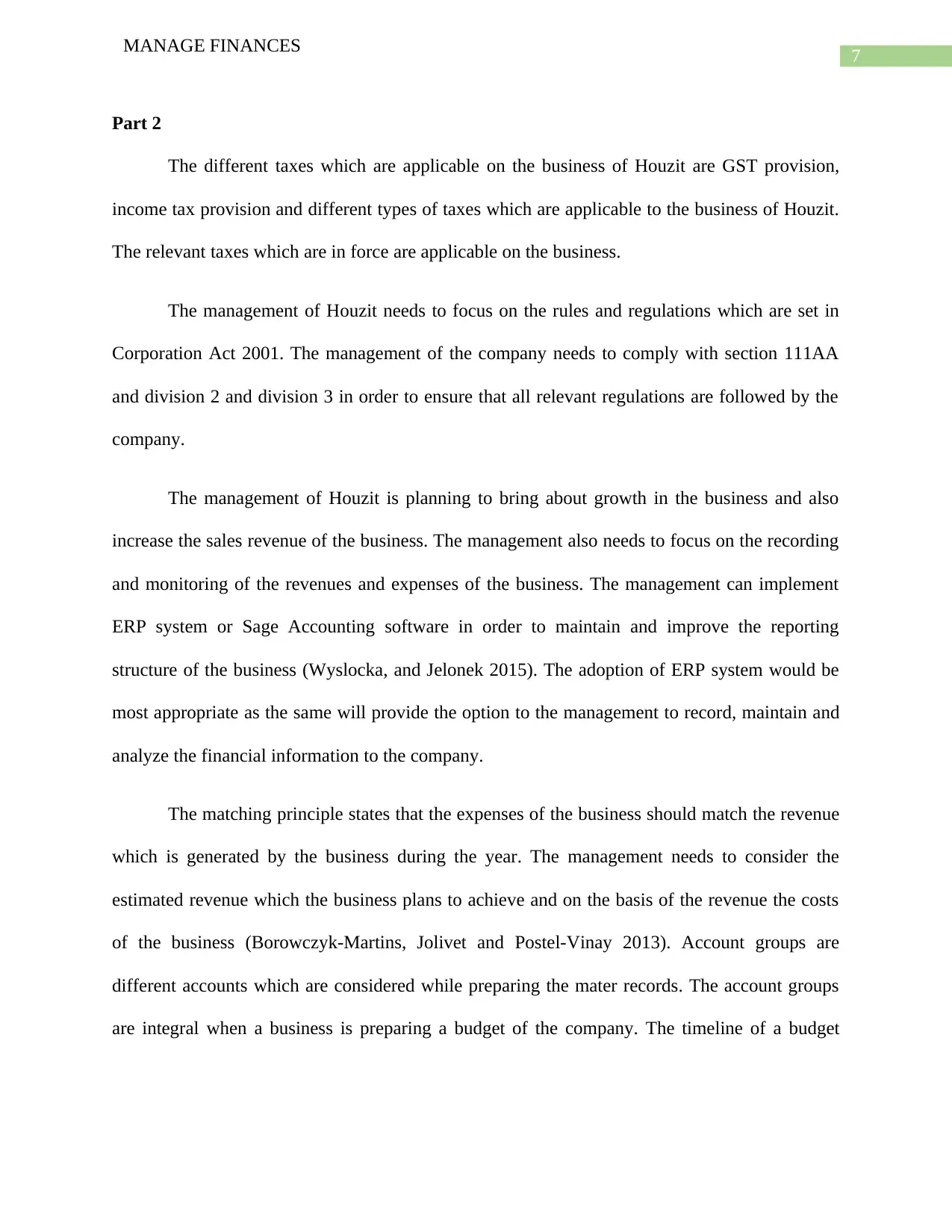
7
MANAGE FINANCES
Part 2
The different taxes which are applicable on the business of Houzit are GST provision,
income tax provision and different types of taxes which are applicable to the business of Houzit.
The relevant taxes which are in force are applicable on the business.
The management of Houzit needs to focus on the rules and regulations which are set in
Corporation Act 2001. The management of the company needs to comply with section 111AA
and division 2 and division 3 in order to ensure that all relevant regulations are followed by the
company.
The management of Houzit is planning to bring about growth in the business and also
increase the sales revenue of the business. The management also needs to focus on the recording
and monitoring of the revenues and expenses of the business. The management can implement
ERP system or Sage Accounting software in order to maintain and improve the reporting
structure of the business (Wyslocka, and Jelonek 2015). The adoption of ERP system would be
most appropriate as the same will provide the option to the management to record, maintain and
analyze the financial information to the company.
The matching principle states that the expenses of the business should match the revenue
which is generated by the business during the year. The management needs to consider the
estimated revenue which the business plans to achieve and on the basis of the revenue the costs
of the business (Borowczyk-Martins, Jolivet and Postel-Vinay 2013). Account groups are
different accounts which are considered while preparing the mater records. The account groups
are integral when a business is preparing a budget of the company. The timeline of a budget
MANAGE FINANCES
Part 2
The different taxes which are applicable on the business of Houzit are GST provision,
income tax provision and different types of taxes which are applicable to the business of Houzit.
The relevant taxes which are in force are applicable on the business.
The management of Houzit needs to focus on the rules and regulations which are set in
Corporation Act 2001. The management of the company needs to comply with section 111AA
and division 2 and division 3 in order to ensure that all relevant regulations are followed by the
company.
The management of Houzit is planning to bring about growth in the business and also
increase the sales revenue of the business. The management also needs to focus on the recording
and monitoring of the revenues and expenses of the business. The management can implement
ERP system or Sage Accounting software in order to maintain and improve the reporting
structure of the business (Wyslocka, and Jelonek 2015). The adoption of ERP system would be
most appropriate as the same will provide the option to the management to record, maintain and
analyze the financial information to the company.
The matching principle states that the expenses of the business should match the revenue
which is generated by the business during the year. The management needs to consider the
estimated revenue which the business plans to achieve and on the basis of the revenue the costs
of the business (Borowczyk-Martins, Jolivet and Postel-Vinay 2013). Account groups are
different accounts which are considered while preparing the mater records. The account groups
are integral when a business is preparing a budget of the company. The timeline of a budget
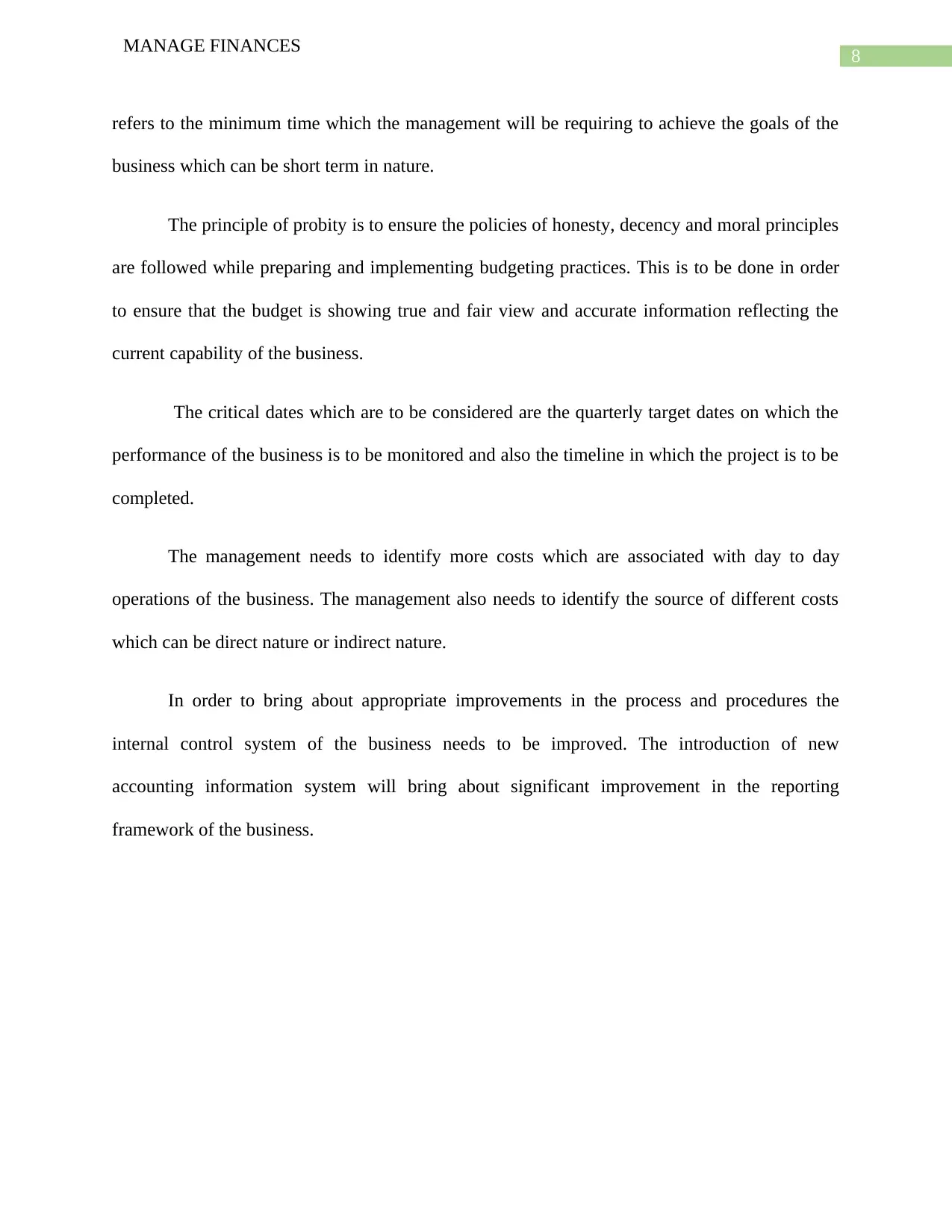
8
MANAGE FINANCES
refers to the minimum time which the management will be requiring to achieve the goals of the
business which can be short term in nature.
The principle of probity is to ensure the policies of honesty, decency and moral principles
are followed while preparing and implementing budgeting practices. This is to be done in order
to ensure that the budget is showing true and fair view and accurate information reflecting the
current capability of the business.
The critical dates which are to be considered are the quarterly target dates on which the
performance of the business is to be monitored and also the timeline in which the project is to be
completed.
The management needs to identify more costs which are associated with day to day
operations of the business. The management also needs to identify the source of different costs
which can be direct nature or indirect nature.
In order to bring about appropriate improvements in the process and procedures the
internal control system of the business needs to be improved. The introduction of new
accounting information system will bring about significant improvement in the reporting
framework of the business.
MANAGE FINANCES
refers to the minimum time which the management will be requiring to achieve the goals of the
business which can be short term in nature.
The principle of probity is to ensure the policies of honesty, decency and moral principles
are followed while preparing and implementing budgeting practices. This is to be done in order
to ensure that the budget is showing true and fair view and accurate information reflecting the
current capability of the business.
The critical dates which are to be considered are the quarterly target dates on which the
performance of the business is to be monitored and also the timeline in which the project is to be
completed.
The management needs to identify more costs which are associated with day to day
operations of the business. The management also needs to identify the source of different costs
which can be direct nature or indirect nature.
In order to bring about appropriate improvements in the process and procedures the
internal control system of the business needs to be improved. The introduction of new
accounting information system will bring about significant improvement in the reporting
framework of the business.
⊘ This is a preview!⊘
Do you want full access?
Subscribe today to unlock all pages.

Trusted by 1+ million students worldwide
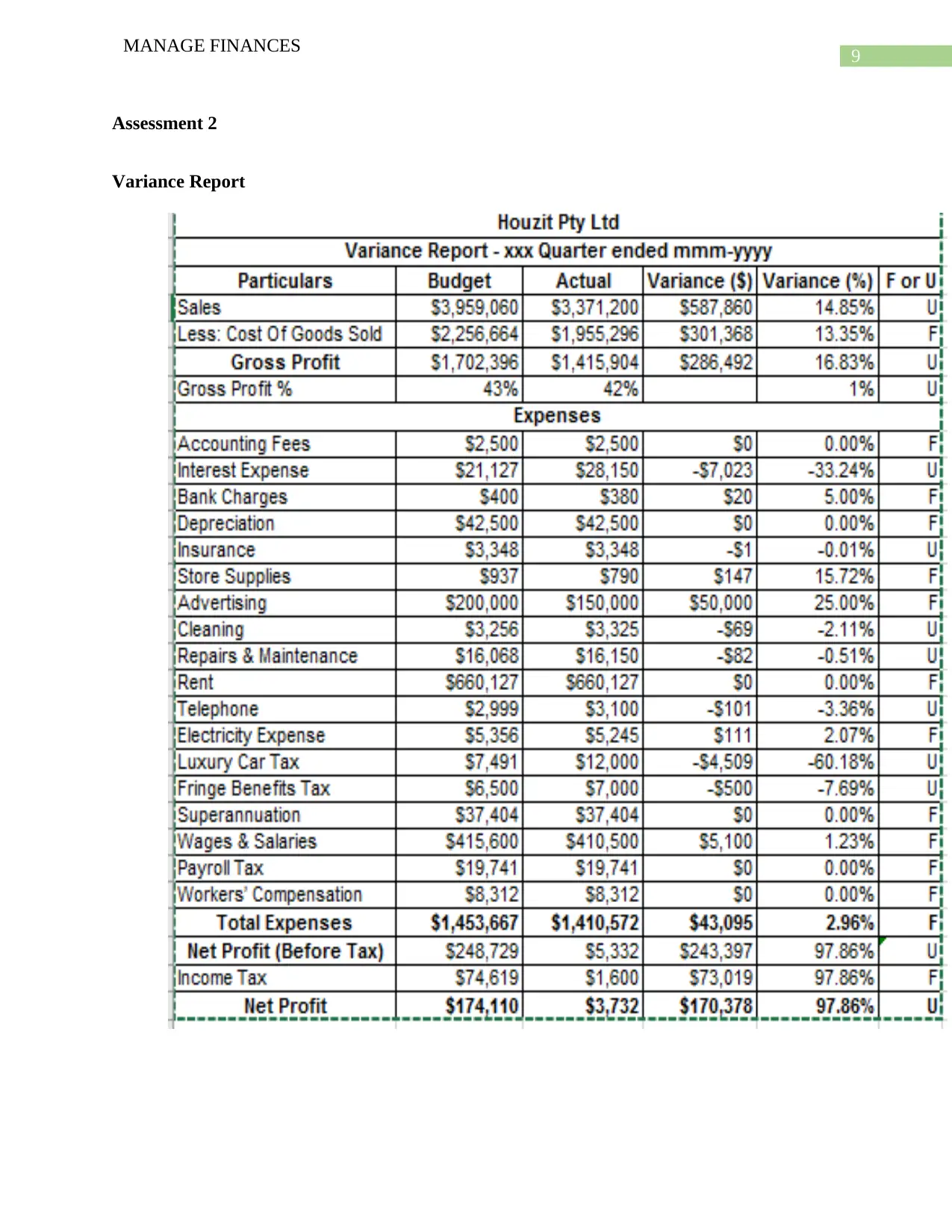
9
MANAGE FINANCES
Assessment 2
Variance Report
MANAGE FINANCES
Assessment 2
Variance Report
Paraphrase This Document
Need a fresh take? Get an instant paraphrase of this document with our AI Paraphraser
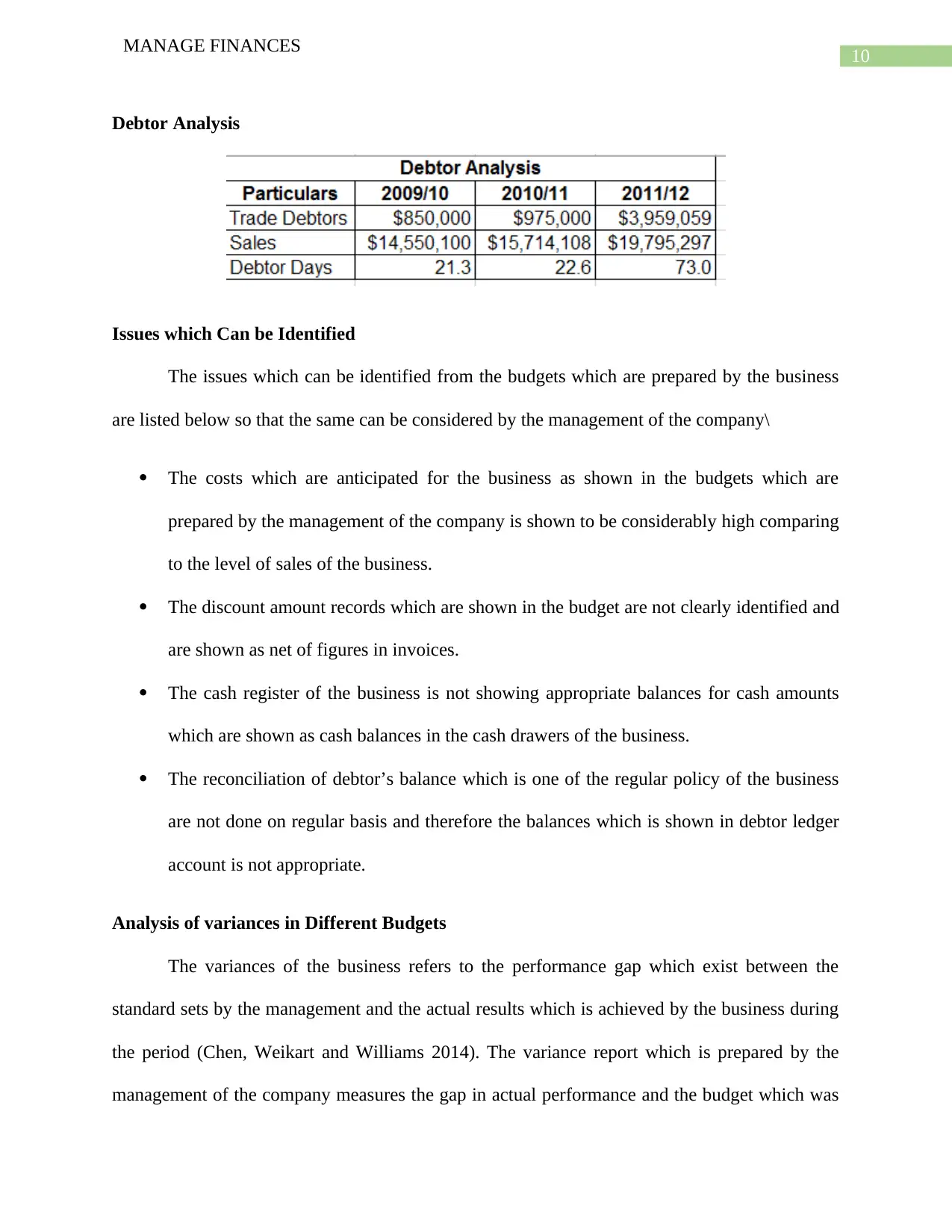
10
MANAGE FINANCES
Debtor Analysis
Issues which Can be Identified
The issues which can be identified from the budgets which are prepared by the business
are listed below so that the same can be considered by the management of the company\
The costs which are anticipated for the business as shown in the budgets which are
prepared by the management of the company is shown to be considerably high comparing
to the level of sales of the business.
The discount amount records which are shown in the budget are not clearly identified and
are shown as net of figures in invoices.
The cash register of the business is not showing appropriate balances for cash amounts
which are shown as cash balances in the cash drawers of the business.
The reconciliation of debtor’s balance which is one of the regular policy of the business
are not done on regular basis and therefore the balances which is shown in debtor ledger
account is not appropriate.
Analysis of variances in Different Budgets
The variances of the business refers to the performance gap which exist between the
standard sets by the management and the actual results which is achieved by the business during
the period (Chen, Weikart and Williams 2014). The variance report which is prepared by the
management of the company measures the gap in actual performance and the budget which was
MANAGE FINANCES
Debtor Analysis
Issues which Can be Identified
The issues which can be identified from the budgets which are prepared by the business
are listed below so that the same can be considered by the management of the company\
The costs which are anticipated for the business as shown in the budgets which are
prepared by the management of the company is shown to be considerably high comparing
to the level of sales of the business.
The discount amount records which are shown in the budget are not clearly identified and
are shown as net of figures in invoices.
The cash register of the business is not showing appropriate balances for cash amounts
which are shown as cash balances in the cash drawers of the business.
The reconciliation of debtor’s balance which is one of the regular policy of the business
are not done on regular basis and therefore the balances which is shown in debtor ledger
account is not appropriate.
Analysis of variances in Different Budgets
The variances of the business refers to the performance gap which exist between the
standard sets by the management and the actual results which is achieved by the business during
the period (Chen, Weikart and Williams 2014). The variance report which is prepared by the
management of the company measures the gap in actual performance and the budget which was
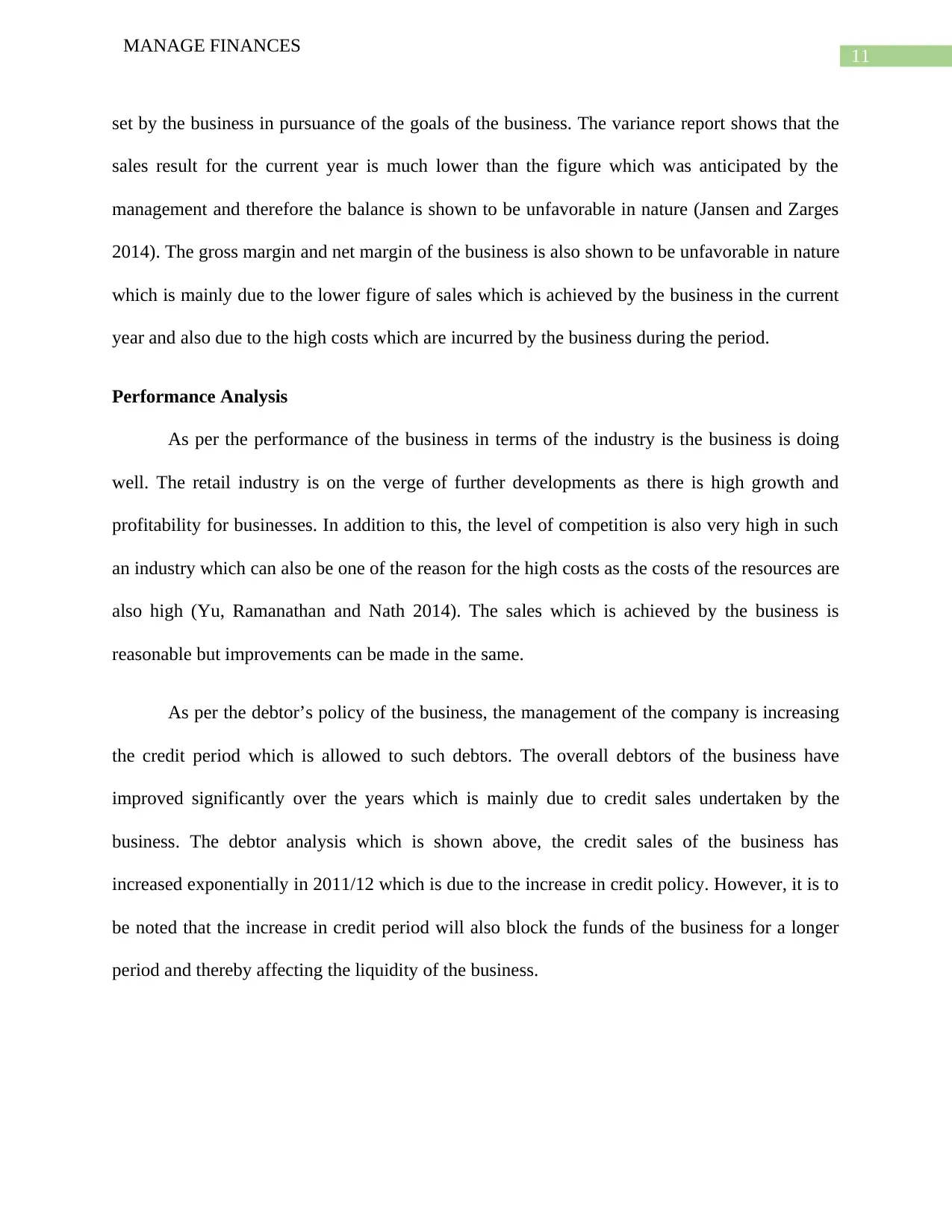
11
MANAGE FINANCES
set by the business in pursuance of the goals of the business. The variance report shows that the
sales result for the current year is much lower than the figure which was anticipated by the
management and therefore the balance is shown to be unfavorable in nature (Jansen and Zarges
2014). The gross margin and net margin of the business is also shown to be unfavorable in nature
which is mainly due to the lower figure of sales which is achieved by the business in the current
year and also due to the high costs which are incurred by the business during the period.
Performance Analysis
As per the performance of the business in terms of the industry is the business is doing
well. The retail industry is on the verge of further developments as there is high growth and
profitability for businesses. In addition to this, the level of competition is also very high in such
an industry which can also be one of the reason for the high costs as the costs of the resources are
also high (Yu, Ramanathan and Nath 2014). The sales which is achieved by the business is
reasonable but improvements can be made in the same.
As per the debtor’s policy of the business, the management of the company is increasing
the credit period which is allowed to such debtors. The overall debtors of the business have
improved significantly over the years which is mainly due to credit sales undertaken by the
business. The debtor analysis which is shown above, the credit sales of the business has
increased exponentially in 2011/12 which is due to the increase in credit policy. However, it is to
be noted that the increase in credit period will also block the funds of the business for a longer
period and thereby affecting the liquidity of the business.
MANAGE FINANCES
set by the business in pursuance of the goals of the business. The variance report shows that the
sales result for the current year is much lower than the figure which was anticipated by the
management and therefore the balance is shown to be unfavorable in nature (Jansen and Zarges
2014). The gross margin and net margin of the business is also shown to be unfavorable in nature
which is mainly due to the lower figure of sales which is achieved by the business in the current
year and also due to the high costs which are incurred by the business during the period.
Performance Analysis
As per the performance of the business in terms of the industry is the business is doing
well. The retail industry is on the verge of further developments as there is high growth and
profitability for businesses. In addition to this, the level of competition is also very high in such
an industry which can also be one of the reason for the high costs as the costs of the resources are
also high (Yu, Ramanathan and Nath 2014). The sales which is achieved by the business is
reasonable but improvements can be made in the same.
As per the debtor’s policy of the business, the management of the company is increasing
the credit period which is allowed to such debtors. The overall debtors of the business have
improved significantly over the years which is mainly due to credit sales undertaken by the
business. The debtor analysis which is shown above, the credit sales of the business has
increased exponentially in 2011/12 which is due to the increase in credit policy. However, it is to
be noted that the increase in credit period will also block the funds of the business for a longer
period and thereby affecting the liquidity of the business.
⊘ This is a preview!⊘
Do you want full access?
Subscribe today to unlock all pages.

Trusted by 1+ million students worldwide
1 out of 14
Related Documents
Your All-in-One AI-Powered Toolkit for Academic Success.
+13062052269
info@desklib.com
Available 24*7 on WhatsApp / Email
![[object Object]](/_next/static/media/star-bottom.7253800d.svg)
Unlock your academic potential
Copyright © 2020–2025 A2Z Services. All Rights Reserved. Developed and managed by ZUCOL.





